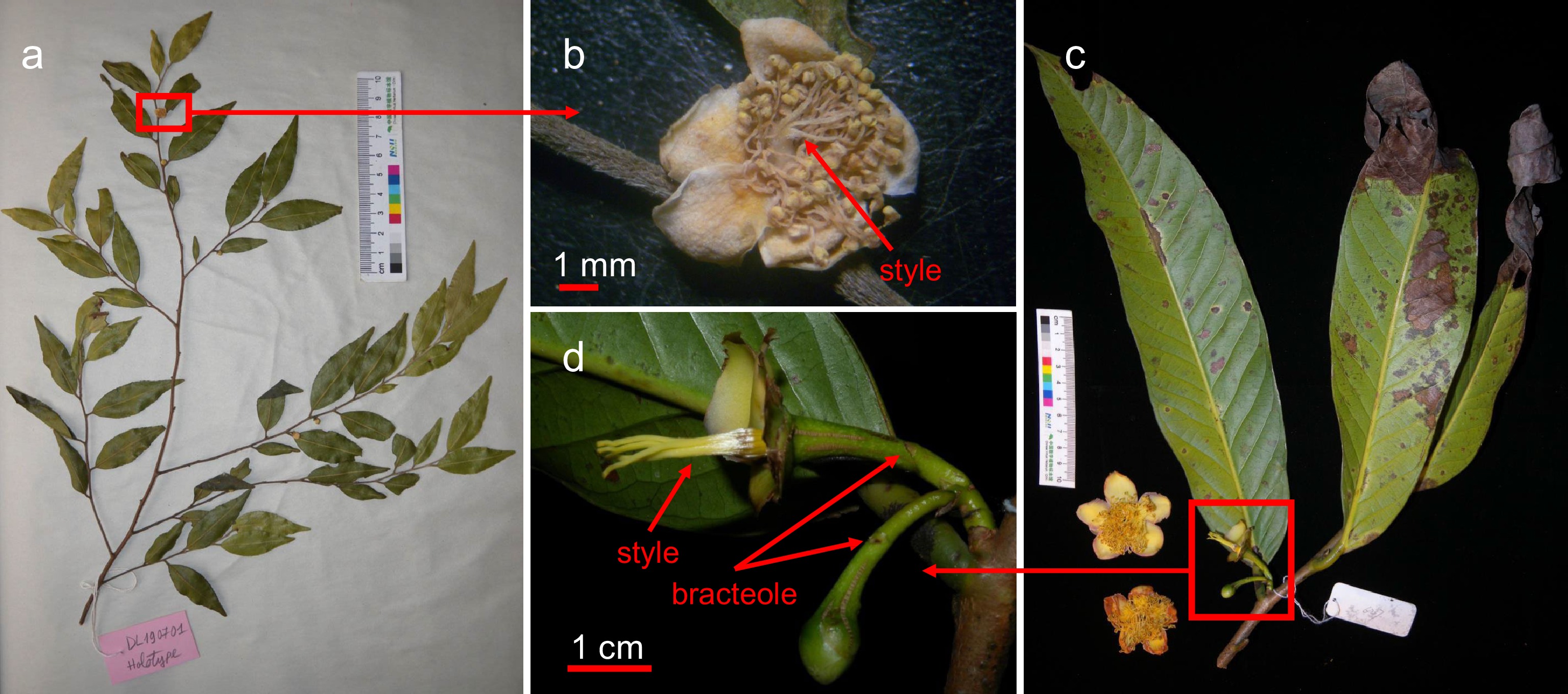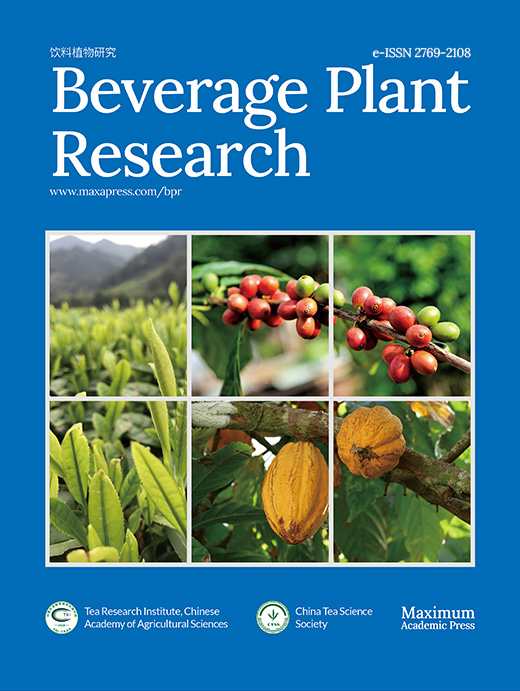-
Tea-plants, one of the most popular beverage plants in the world, belong to Camellia L. sect. Thea (L.) Griff. in taxonomy. There are 12 or 32 species in this section in different classification systems, distributed in East and Southeast Asia. In China almost all species can be found[1−3]. Four new members of this section have been described in Vietnam, including Camellia vidalii Rosmann in 1999[4], C. tenuistipa Orel, Curry et Luu in 2015[5], C. sinensis var. dulcamara Q.U. Le et Nguyen in 2020[6] and C. flosculora Curry, V.S. Le, C.Q. Truong et V.D. Luong in 2021[7]. Camellia tenuistipa was treated as a heterotypic synonym of C. sinensis (L.) Kuntze var. assamica (Hook.) Steens by Zhao et al. in 2017[8]. After scrutinizing the literature and specimens of these taxa, some taxonomic problems of the remaining three taxa were found and are discussed below.
The relevant literature including the protologues of these names were studied. The specimens (or their images) conserved at herbaria (acronyms based on Thiers[9]) BM, DLU, E, GXFI, IBK, IBSC, K, NSW, P, PE, SYS, TEA and VNM were checked. The priority of a name was evaluated under Art. 11.4 of the Shenzhen Code (hereafter ICN)[10].
Taxonomic treatment of Camellia sinensis var. dulcamara Q.U. Le et Nguyen
-
Camellia sinensis var. pubilimba Hung T. Chang, Acta Sci. Nat. Univ. Sunyats. 20 (1): 98. 1981[11]
Type: China, Guangxi, Lingyun, Herb. Guangxi For. Inst. 4209 (holotype: SYS; isotype: PE!)
----Camellia sinensis var. dulcamara Q.U. Le & Nguyen, Journ. New Biol. Rep. 9 (1): 46. 2020.[6], syn. nov. Type: Vietnam, Bac Kan province, Le Ung TN20012018 (holotype: VNM; isotype: Thai Nguyen University of Agriculture and Forestry).
Camellia sinensis var. pubilimba was published twice as new variety by the same authors in the same year: in Acta Scientiarum naturalium Universitatis Sunyatseni in Feburary 1981[11] and in A Taxonomy of the Genus Camellia in April 1981[12]. The later isonym[12] has no nomenclatural status (Art. 6. 2 of the ICN).
Le et al.[6] stated that C. sinensis var. dulcamara was different from C. sinensis var. assamica by its white petals (vs. with a tinge of green at apex for the latter) with pubescent on both sides (vs. glabrous for the latter). The description of the petals with a green apex of var. assamica is incomplete. In fact, only the outermost petals have green apex, which is very common in sect. Thea even in genus Camellia[1−3, 13], and is not unique to var. assamica. There are three or four varieties under C. sinensis, in which, var. pubilimba is characterized by hairy sepals and petals[1−3, 10,11, 14,15]. Petals white with pubescent on both sides, the diagnostic character of var. dulcamara[6], is shared by var. pubilimba. All features, especially the pubescence on the back of sepals, clearly support that var. dulcamara should be reduced into var. pubilimba.
Taxonomic position of Camellia flosculora Curry et al. (Fig. 1a, b)
-

Figure 1.
Morphological characteristics of (a), (b) Camellia flosculora (Luong Van Dung DL 190701, DLU) and (c), (d) C. vidalii (S.X. Yang 6237, KUN). (a), (c) Flowering shoots; (b) flower, showing corolla, stamens and pistil; (d) a flower-bud and a flower without corolla and stamens. Photos by S.X. Yang.
In the protologue[7], C. flosculora was placed in C. sect. Thea ser. Sinenses Hung T. Chang based on its '3-loculed, pubescent ovaries and 3-parted, free styles', and distinguished from other species of ser. Sinenses by its 'small leaf blades (3–7 × 1.5–2.5 cm), short pedicels (0.3–0.4 mm), very small flowers (0.5–0.7 cm diameter), short stamens (2–3 mm) and short styles (1.5–1.7 mm)'. However, very small flowers (< 1 cm diameter), short pedicels (< 0.5 cm), short stamens (< 1 cm) and short styles (< 0.5 cm) are completely absent in whole sect. Thea (not only in ser. Sinenses), instead, together with its persistent bracteoles, 3-loculed ovaries and free styles, are diagnostic to sect. Corallina Sealy[2,3, 13,14] or sect. Brachyandra Hung T. Chang[1, 12, 16], which strongly suggests that it is problematic to put C. flosculora in sect. Thea.
Although a few taxa with persistent bracteoles or/and free styles were temporarily or inappropriately placed in sect. Thea[2, 11−13, 17], it should be emphasized that bracteoles early deciduous and styles connate, which are absent in C. flosculora, are the most important diagnostic features of sect. Thea.
Sealy[13] included two species, C. gracilipes (bracteoles persistent and styles connate) and C. pubicosta (bracteoles persistent and styles free), in sect. Thea, but he explicitly pointed out that the both 'are regarded as anomalous and are placed in section Thea as a matter of convenience'. Subsequently, C. gracilipes was removed into sect. Longissima Hung T. Chang by Chang in 1981[12] and sect. Longipedicellata Hung T. Chang (including sect. Longissima) by Ming in 1999[17], respectively, and C. pubicosta was removed into sect. Corallina by Ming in 1999[17].
'Bracts (actually bracteoles) 2, early deciduous' and 'styles free or lower half connate' were listed in the diagnosis of Chang's sect. Thea[1, 11,12, 16], in which, however, there were only two species with free styles, i.e., C. pentastyla and C. pubicosta. Ming[14] and our examination of type specimens have confirmed that the styles of C. pentastyla are united at the base. As for C. pubicosta, its persistent bracteoles clearly indicate that its placement in sect. Thea is inconsistent with the diagnosis described above[1, 11,12, 16]. The diagnostic value of bracteoles early deciduous to sect. Thea has been widely recognized[1−3, 10−11, 13,14, 16] and free styles are virtually absent in sect. Thea. Recently, C. sealyana, the unique species with free style in Ming's sect. Thea, was excluded from this section by Zhao[18].
From what has been discussed above, the main characteristics of C. flosculora, especially the very small flowers, short stamens and free styles (Fig. 1a,b), undoubtedly show that it does not belong to sect. Thea, but a member of sect. Corallina (sensu Ming[2, 17], including sect. Brachyandra).
Taxonomic position of Camellia vidalii Rosmann (Fig. 1c, d)
-
Camellia vidalii was described in Adansonia (in French with a Latin diagnosis) in 1999[4], a valid publication. An English description of this species was presented in the International Camellia Journal in 2000[19]. This species was characterized by very large leaves (35–40 cm long and 6–8 cm wide), long pedicels (3.5–4.5 cm long), persistent bracteoles, yellow flowers, (4-)5-loculated ovaries and free styles. C. vidalii was first provisionally included in sect. Archecamellia Sealy by Rosmann in 1999, who suggested that it was close to C. krempfii (Gagnep.) Sealy and C. longissima Hung T. Chang[4]. In the following year, Rosmann definitely moved C. vidalii into sect. Thea ser. Quinquelocularis Hung T. Chang. However, inexplicably, in the last paragraph of the same article, the author returned his previous opinion, placing it in sect. Archecamellia[19].
Section Thea is characterised by the caducous bracteoles (2 or 3), white petals and the single style[1–3, 13], which are absent in C. vidalii. Apparently, it is inappropriate to place C. vidalii in sect. Thea. With the large leaves, long pedicels, persistent bracteoles, yellow petals, (4-)5-loculed ovaries and free styles (Fig. 1c, d), as well as the molecular phylogenetic analysis[20], it is suggested to put C. vidalii in sect. Piquetia.
This work was financially supported by the National Natural Science Foundation of China (32270224, 31270246, 31770219), the Special Fund of Guangxi Forestry and Grassland Bureau (GXFS-2021-34). I thank the staff of herbaria listed in the Materials and Methods for supplying specimens or their images/photos. We also thank Y.Z. Jiang (KUN) for her help to prepare the plates.
-
The authors declare that they have no conflict of interest.
- Copyright: © 2023 by the author(s). Published by Maximum Academic Press, Fayetteville, GA. This article is an open access article distributed under Creative Commons Attribution License (CC BY 4.0), visit https://creativecommons.org/licenses/by/4.0/.
-
About this article
Cite this article
Thanh NT, Van Dung L, Hai Ninh LN, Truong QC, Yang S. 2022. Taxonomic notes of three tea-plants (Camellia sect. Thea) recently described in Vietnam. Beverage Plant Research 2:21 doi: 10.48130/BPR-2022-0021
Taxonomic notes of three tea-plants (Camellia sect. Thea) recently described in Vietnam
- Received: 14 October 2022
- Accepted: 31 October 2022
- Published online: 02 December 2022
Abstract: Camellia sinensis var. dulcamara is a heterotypic synonym of C. sinensis var. pubilimba. Camellia flosculora and C. vidalii were excluded from sect. Thea.
-
Key words:
- Camellia sect. Thea /
- new species /
- taxonomic revision /
- tea plant /
- Vietnam













